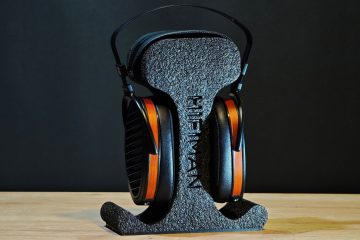Hipdac 3 is the latest product in Ifi’s Hipdac series. Available for $199.
Specs
–> Input: USB-C
–> Formats Supported: DSD 256 / 11.3MHz | PCM 384kHz | MQA Full Decoder
–> DAC: Bit-Perfect DSD & DXD DAC by Burr Brown
–> Outputs: BAL 4.4mm | S-BAL 3.5mm
–> Power Output
BAL: 400mW @ 32Ω | 6.3V @ 600Ω
S-BAL: 280mW @ 32Ω | 3.2V @ 600Ω
–> Output Impedance: ≤ 1Ω (BAL/S-BAL) | w/ iEMatch on: ≤ 4.5Ω
–> SNR + DNR: BAL < 109dBA @ 0dBFS | S-BAL <103dBA @ 0dBFS
–> THD+N
BAL: < 0.006% (360mW/2V @ 600Ω)
S-BAL: < 0.01% (100mW/1.27V @ 32Ω)
–> Frequency Response: 20Hz – 45kHz (-3dB)
–> Battery: Lithium-polymer 2200mAh approx. 8 hours
–> Power System: charge via USB-C | BC V1.2 compliant up to 1000mA charging current
–> Power Consumption: < 2W idle, 4W max
–> Dimensions: 4.0″ x 2.8″ x 0.6″
–> Net weight: 0.3 lbs (137g)

Build
Box contents:
Hipdac 3
Type c to type a cable, type c to type c cable, type c to lightning cable
Sticker and stabilizer pad (4 pcs)
Instructions for use and a warranty card come with it.
It looks like a small flask. The metal surface feels like it will be scratched, I make sure that my pocket is empty when I put it in my pocket. Other than that, it feels quite high quality in the hand. Unfortunately, it’s extremely scratchable. And they sell a case for 30 dollars for this beautiful device. Capitalism. The ports and switchs seem like they will not break easily. Hipdac 3 has 4.4 and 3.5 outputs on it. It has two type c outputs. It has a potentiometer for volume adjustment, this is also the on off button.
The cables that come out of the box are also of sufficient quality. Only the fabric covered ones (the yellow ones) are a bit stiff and hard to bend.

Sound
You will like what you read in this part.
We can say its a bit warm. Apart from that, you get a good resolution and an incredible imaging for the price band. The Hipdac 3 reproduces a very natural and realistic sound and does so without destroying the low frequencies as some devices do.
This $199 device has technical specifications that will crush many entry/mid-level devices. Detail reproduction is not extreme but very good, if you are listening to a high quality format you can easily get microdetails (this also depends on the headphones you are using). I think the output power is enough for everything except for some limited headphones and extremely difficult to drive overears. Maybe it won’t scream at 600ohm, but it’s sure to be loud enough.

Usability
The way it’s used reminds me of the Fiio Q1mk2. Of course the Hipdac 3 sounds much better.
I would like to categorize the use of this device in two categories: desktop and portable. From a desktop point of view, there is no problem. It can already drive many over-ear headphones. Portable, it’s not easy to carry in a pocket, but it plays better than any dongle. Easy to carry in a coat pocket in winter. In summer it can be challenging when you’re just wearing shorts and a T-shirt.
There are 3 main advantages over dongles. Sound, power and iEMatch. iEMatch is a technology that optimizes sound for sensitive earphones and especially for iEMs. This technology allows you to get the maximum out of both a hard-driving over-ear headphone and a sensitive iem with the same amp. All this makes the size of this device tolerable for “portable” use.
When we look at the other functions, you can think of the Power match button as H/L mode. XBass increases the lower frequencies very clearly and distinctly. I can say that I found it successful for hiphop and edm.
Battery
As for battery life, it’s not bad, but honestly not enough. Roughly 10 hours in daily use tests. We usually see 10 hours of performance in this type of amp/dac but i think this is insufficient because the device cannot transmit and charge from a single port at the same time. There are two different ports for these. This is good for signal quality and good for desktop use (you can charge and transmit from two ports. But it is a disadvantage for portable use. Wouldn’t it be nice if there was a technology/mode that could perform both functions from a single port when the battery is about to run out?
The big problem is that the standby time of Hipdac 3 is the same as the charging time. So as long as the device is on, the battery runs out in 10-12 hours. It doesn’t matter if you use it or not. It’s too bad because you can just forget it’s on (I did) and suddenly you’re left with a metal brick with an empty battery.

Hipdac 3 vs Hipdac 2
The first thing that stands out is the iEMatch feature with Hipdac 3. Next is the type c instead of type a in Hipdac 2. As an upgrade, Hipdac 3 uses metal film capacitors and a low phase noise crystal oscillator. Both devices have the same dac chip.
The result? Both have similar output power and the same sound profile (the Hipdac series almost no play with the source audio), while the Hipdac 3 has a slightly more refined sound, slightly better separation and imaging. There is no night and day difference, just a slight difference. Add iEMatch (which works very well) and you can decide if the upgrade is fair or not.

Epilogue
It’s a device that does the best it can for its price in terms of sound. For desktop use, you might want to consider something bigger, but this is good enough. If you’re going portable, it’s not as easy as a dongle. If you have a good phone, I think it’s a much cheaper and more reasonable option than buying a DAP (put your money on headphones).











